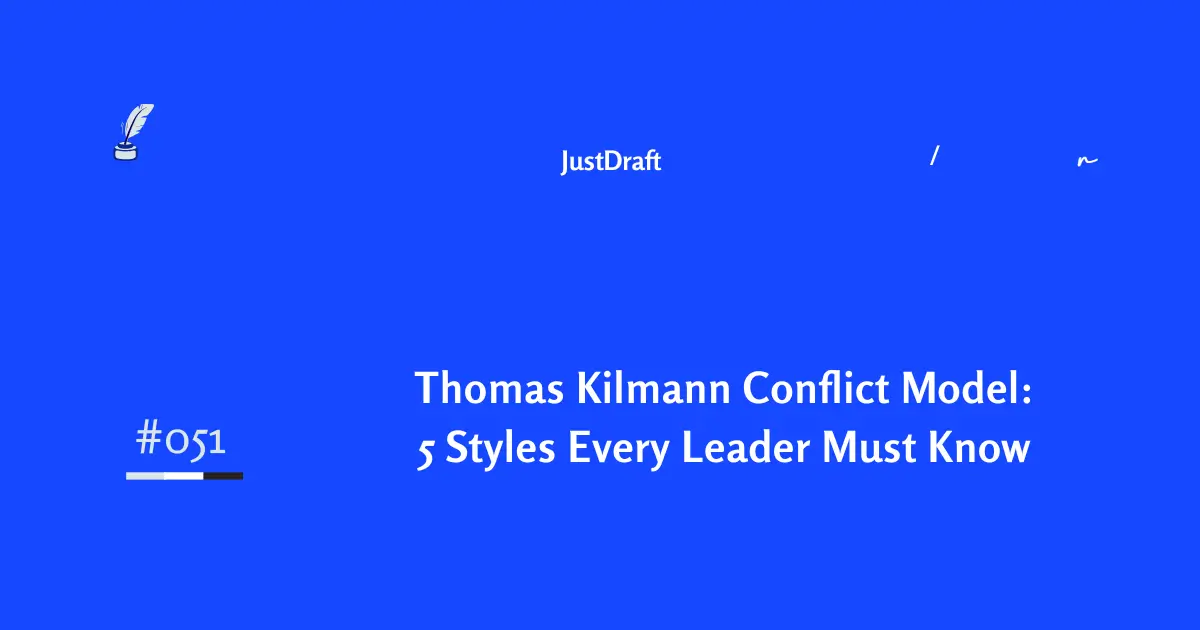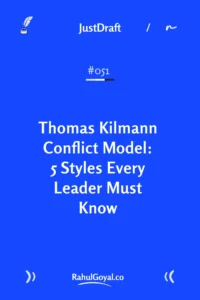Conflict Resolution Using the Thomas Kilmann Model: A Practical Guide
Let’s talk about something that happens in every workplace, every single day: conflict.
You know that feeling when two team members disagree on a project approach? Or when you need to make an unpopular decision? Or when everyone’s so stressed that small issues blow up into big problems?
Here’s the reality: 85% of employees experience workplace conflict. If you’re a manager, you’re probably spending about 10 hours every week dealing with it. That’s a full workday gone, just managing disagreements.
But here’s the thing most people miss: conflict isn’t the enemy. How you handle it is what matters.
One Topic: Conflict Resolution with The Thomas Kilmann Model
The Tool That Changed Everything
Back in 1974, two psychologists named Kenneth Thomas and Ralph Kilmann created something simple but powerful. They called it the Thomas Kilmann Conflict Mode Instrument, or TKI for short.
Their big insight? There’s no single “right way” to handle conflict. Instead, there are five different approaches, and each one works better in different situations.
Think of it like having five different tools in your toolbox. You wouldn’t use a hammer for every job, right? Same with conflict.
The Two Questions That Matter
The TKI is built on two simple ideas:
First: How assertive are you? Are you pushing for what you want?
Second: How cooperative are you? Are you trying to help others get what they want?
Mix these two in different ways, and you get five distinct approaches to handling conflict.
The Five Ways to Handle Conflict
1. Competing: “My Way”
This is when you go all-in on what you want. High assertiveness, low cooperation.
Here’s where it makes sense: Emergencies. Crisis situations. Those moments when you need to make a tough call fast and there’s no time for discussion.
The catch: Only 4.3% of professionals use this as their main style. Why? Because it damages relationships. Nobody likes feeling steamrolled.
I once saw a manager use this approach during a security breach. Files were being accessed illegally, and there was no time to discuss options. He shut down the system immediately, dealt with the angry calls later. That was competing done right.
But the manager who uses this style for every decision? Their team eventually stops caring.
2. Collaborating: “Our Way”
This is the gold standard. High assertiveness, high cooperation. You’re working together to find a solution that makes everyone happy.
The numbers tell the story: Almost 60% of professionals say this is their favorite approach.
This shines in: Complex problems. Long-term projects. Situations where you need everyone committed to the solution.
The reality check: It takes time. A lot of time. You can’t collaborate on everything, or you’ll never get anything done.
Think about redesigning your entire workflow. That’s worth collaborating on. Picking where to order lunch? Not so much.
3. Compromising: “Meet in the Middle”
This is the practical approach. Both sides give a little, both sides get a little. Moderate assertiveness, moderate cooperation.
You’ll reach for this during: Daily decisions. Time crunches. Those moments when you need to move forward but perfect isn’t possible.
About 24% of professionals use this as their go-to style. And get this: 70.7% of people say they pick their battles carefully. That’s compromising in action.
Here’s a real example: Two departments both want the conference room at 2 PM. Instead of fighting about it, one takes 1 PM, the other takes 3 PM. Problem solved in two minutes.
4. Avoiding: “Not Now”
Sometimes the best move is no move at all. Low assertiveness, low cooperation.
This actually helps when: The issue is truly minor. Emotions are running too high. You need more information before deciding.
Only 4.6% of people prefer this style, but here’s the interesting part: 19.4% admit they avoid difficult conversations. That gap tells you something people use this more than they’d like to admit.
I’ve seen this work well when two team members were arguing while both exhausted from a deadline push. Smart move? Table the discussion for next week when everyone’s calmer.
Bad move? Ignoring a pattern of missed deadlines because you don’t want the awkward conversation.
5. Accommodating: “Your Way”
This is when you let the other person have what they want. Low assertiveness, high cooperation.
This approach works best: The issue matters more to them than to you. You were wrong. Preserving the relationship is more important than winning.
Only 6.8% of people say this is their main style. But 55.7% say they prioritize restoring harmony even when it means setting aside their own needs.
Last month, I disagreed with my team on a marketing approach. But they’d done the research, they’d be doing the work, and honestly? My preference was just that a preference, not backed by data. So I accommodated. They owned it, they executed brilliantly, and I learned something new.
The Real Cost of Getting It Wrong
Let’s be honest about what’s at stake:
- 23% of employees have left jobs because of conflict. That’s not just about hurt feelings. That’s talent walking out the door, taking their knowledge with them.
- 49% of conflicts come from egos and personality clashes. Not strategy disagreements. Not resource constraints. Just people being people.
- 18% have seen projects fail directly because of unresolved conflict.
Here’s what this means for you as a leader: the way you handle conflict either builds your team or breaks it.
Your Conflict Strategy Quick Guide
Got a crisis? Compete. Decide fast, explain later. Your team needs clarity, not a committee.
Building something new? Collaborate. Get everyone’s ideas. The time you invest now saves months of pushback later.
Daily decisions piling up? Compromise. Move things forward. Perfect is the enemy of done.
Trivial issue that’ll blow over? Avoid. Save your energy for battles that matter.
Someone’s clearly right and you’re clearly wrong? Accommodate. Your ego isn’t worth damaging the relationship.
The Pattern You Need to Watch
Here’s something most managers miss: your default conflict style.
We all have one. That automatic response that kicks in when tension rises. For most people, it’s collaborating (remember that 60%?). Sounds great, right?
Except when you’re trying to collaborate on everything. The team meeting that should take 30 minutes stretches to two hours. Simple decisions become complex debates. People start wondering if you can actually make a decision.
The flip side? A manager who competes on everything. Sure, decisions get made fast. But good people leave, ideas dry up, and eventually you’re leading a team of yes-people who stopped caring.
Making This Work in Real Life
Start here: For the next week, notice your conflicts. Not just the big ones all of them.
That disagreement about the project timeline? How did you handle it?
The team member who pushed back on your idea? What was your response?
The choice between two equally good options? What did you do?
Write them down. Then ask yourself: Did I use the right approach for that situation?
You’ll start seeing patterns. Maybe you avoid more than you should. Maybe you compromise when you should collaborate. Maybe you compete when accommodating would work better.
The goal isn’t to be perfect. It’s to be intentional.
The Bottom Line
Thomas and Kilmann’s insight from 50 years ago still holds true: there’s no single right way to handle conflict.
The best leaders? They match their approach to the situation. They compete in a crisis. They collaborate on strategy. They compromise on logistics. They avoid trivial issues. They accommodate when it makes sense.
They understand that conflict isn’t the problem, inflexibility is.
So next time you’re facing a conflict, pause. Ask yourself two questions:
How important is this issue to me? How important is the relationship?
Your answers will tell you which tool to reach for.
And remember: your team is watching how you handle conflict. You’re not just solving today’s problem, you’re teaching them how to solve tomorrow’s.

Interested in travel, read last week’s LensLetter newsletter about Five Wireless Photography Tricks.
Read last week’s JustDraft about The First Principle.
Two Quotes to Inspire
The measure of leadership is not avoiding conflict, but knowing which battles to fight, which to negotiate, and which to walk away from entirely.
Great leaders don’t have a favourite conflict style, they have the wisdom to match their approach to what the moment demands.
One Passage From My Bookshelf
The courage of leadership is giving others the chance to succeed even though you bear the responsibility for getting things done. Great leaders don’t shy away from conflict, they use it to build trust. Disagreement, when handled with respect, strengthens relationships rather than weakens them. Leaders set the tone. If they welcome dissent and curiosity, their teams learn to challenge without fear. It’s how ideas grow stronger, through friction, not comfort.
📚From Leaders Eat Last by Simon Sinek


